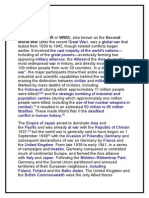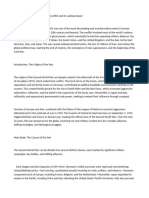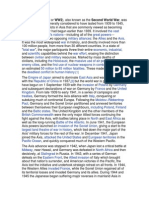0 ratings0% found this document useful (0 votes)
41 viewsWorld War 2
World War 2
Uploaded by
JACK ANTHONY VAZQUEZ HERNANDEZWorld War II was a global war lasting from 1939 to 1945, involving most of the world's nations that were split into two opposing military alliances: the Allies and the Axis powers. Over 70 million people died, making it the deadliest conflict in history. Key events included Germany's invasion of Poland in 1939, Germany and Italy's conquest of much of Europe, Japan's attacks against Western territories which brought the US into the war, major turning points such as the Battle of Midway in 1942 and the defeat of Axis forces at Stalingrad, and the Allied invasions of German-occupied Western Europe and islands in the Pacific in 1944-1945 which ultimately led to the defeat of Germany and Japan.
Copyright:
© All Rights Reserved
Available Formats
Download as DOCX, PDF, TXT or read online from Scribd
World War 2
World War 2
Uploaded by
JACK ANTHONY VAZQUEZ HERNANDEZ0 ratings0% found this document useful (0 votes)
41 views1 pageWorld War II was a global war lasting from 1939 to 1945, involving most of the world's nations that were split into two opposing military alliances: the Allies and the Axis powers. Over 70 million people died, making it the deadliest conflict in history. Key events included Germany's invasion of Poland in 1939, Germany and Italy's conquest of much of Europe, Japan's attacks against Western territories which brought the US into the war, major turning points such as the Battle of Midway in 1942 and the defeat of Axis forces at Stalingrad, and the Allied invasions of German-occupied Western Europe and islands in the Pacific in 1944-1945 which ultimately led to the defeat of Germany and Japan.
Copyright
© © All Rights Reserved
Available Formats
DOCX, PDF, TXT or read online from Scribd
Share this document
Did you find this document useful?
Is this content inappropriate?
World War II was a global war lasting from 1939 to 1945, involving most of the world's nations that were split into two opposing military alliances: the Allies and the Axis powers. Over 70 million people died, making it the deadliest conflict in history. Key events included Germany's invasion of Poland in 1939, Germany and Italy's conquest of much of Europe, Japan's attacks against Western territories which brought the US into the war, major turning points such as the Battle of Midway in 1942 and the defeat of Axis forces at Stalingrad, and the Allied invasions of German-occupied Western Europe and islands in the Pacific in 1944-1945 which ultimately led to the defeat of Germany and Japan.
Copyright:
© All Rights Reserved
Available Formats
Download as DOCX, PDF, TXT or read online from Scribd
Download as docx, pdf, or txt
0 ratings0% found this document useful (0 votes)
41 views1 pageWorld War 2
World War 2
Uploaded by
JACK ANTHONY VAZQUEZ HERNANDEZWorld War II was a global war lasting from 1939 to 1945, involving most of the world's nations that were split into two opposing military alliances: the Allies and the Axis powers. Over 70 million people died, making it the deadliest conflict in history. Key events included Germany's invasion of Poland in 1939, Germany and Italy's conquest of much of Europe, Japan's attacks against Western territories which brought the US into the war, major turning points such as the Battle of Midway in 1942 and the defeat of Axis forces at Stalingrad, and the Allied invasions of German-occupied Western Europe and islands in the Pacific in 1944-1945 which ultimately led to the defeat of Germany and Japan.
Copyright:
© All Rights Reserved
Available Formats
Download as DOCX, PDF, TXT or read online from Scribd
Download as docx, pdf, or txt
You are on page 1of 1
World War
II or the Second World War, often abbreviated as WWII or WW2, was a global
conflict that lasted from 1939 to 1945. The vast majority of the world's countries, including all of
the great powers, fought as part of two opposing military alliances: the Allies and the Axis.
Many participants threw their economic, industrial, and scientific capabilities behind this total
war, blurring the distinction between civilian and military resources. Aircraft played a major
role, enabling the strategic bombing of population centres and the delivery of the only two
nuclear weapons ever used in war.
World War II was by far the deadliest conflict in human history; it resulted in 70 to 85 million
fatalities, mostly among civilians. Tens of millions died due to genocides (including the
Holocaust), starvation, massacres, and disease. In the wake of the Axis
defeat, Germany and Japan were occupied, and war crimes tribunals were conducted against
German and Japanese leaders.
The causes of World War II are debated, but contributing factors included the Second Italo-
Ethiopian War, Spanish Civil War, Second Sino-Japanese War, Soviet–Japanese border
conflicts, the rise of fascism in Europe, and European tensions in the aftermath of World War I.
World War II is generally considered to have begun on 1 September 1939, when Nazi
Germany, under Adolf Hitler, invaded Poland. The United
Kingdom and France subsequently declared war on Germany on 3 September. Under
the Molotov–Ribbentrop Pact of August 1939, Germany and the Soviet Union had
partitioned Poland and marked out their "spheres of influence" across Finland, Estonia, Latvia,
Lithuania and Romania. From late 1939 to early 1941, in a series of campaigns and treaties,
Germany conquered or controlled much of continental Europe, and formed the Axis alliance
with Italy and Japan (with other countries later). Following the onset of campaigns in North
Africa and East Africa, and the fall of France in mid-1940, the war continued primarily between
the European Axis powers and the British Empire, with war in the Balkans, the aerial Battle of
Britain, the Blitz of the United Kingdom, and the Battle of the Atlantic. On 22 June 1941,
Germany led the European Axis powers in an invasion of the Soviet Union, opening
the Eastern Front, the largest land theatre of war in history.
Japan, which aimed to dominate Asia and the Pacific, was at war with the Republic of China by
1937. In December 1941, Japan attacked American and British territories with near-
simultaneous offensives against Southeast Asia and the Central Pacific, including an attack on
the US fleet at Pearl Harbor which resulted in the United States and United Kingdom declaring
war against Japan. The European Axis powers declared war on the United States in solidarity.
Japan soon captured much of the western Pacific, but its advances were halted in 1942 after
losing the critical Battle of Midway; later, Germany and Italy were defeated in North Africa and
at Stalingrad in the Soviet Union. Key setbacks in 1943—including a series of German defeats
on the Eastern Front, the Allied invasions of Sicily and the Italian mainland, and Allied
offensives in the Pacific—cost the Axis powers their initiative and forced them into strategic
retreat on all fronts. In 1944, the Western Allies invaded German-occupied France, while the
Soviet Union regained its territorial losses and pushed Germany and its allies back. During
1944 and 1945, Japan suffered reversals in mainland Asia, while the Allies crippled
the Japanese Navy and captured key western Pacific islands.
You might also like
- If Wwi Was A Bar Fight ScriptDocument6 pagesIf Wwi Was A Bar Fight Scriptapi-30741753667% (6)
- World War 2Document4 pagesWorld War 2zaindopasiNo ratings yet
- World War II War (1 September 1939 - 2 SeptemberDocument7 pagesWorld War II War (1 September 1939 - 2 SeptemberjoshithavallabineniNo ratings yet
- WW 2Document2 pagesWW 2giberozashviliNo ratings yet
- WehrmachtDocument1 pageWehrmachtghasemikasra39No ratings yet
- World War IIDocument1 pageWorld War IIkarlaNo ratings yet
- World War IIDocument1 pageWorld War IIGiggiNo ratings yet
- World War IIDocument12 pagesWorld War IIIvan LachicaNo ratings yet
- World War IIDocument2 pagesWorld War IIhuseikha velayazulfahdNo ratings yet
- World War II (WWII or WW2), Also Known As The Second World War, Was ADocument2 pagesWorld War II (WWII or WW2), Also Known As The Second World War, Was AMoimen Dalinding UttoNo ratings yet
- World War II (Often Abbreviated To WWII or WW2), Also Known As The Second World War, WasDocument1 pageWorld War II (Often Abbreviated To WWII or WW2), Also Known As The Second World War, WasSatheesh KumarNo ratings yet
- World War 2 NotesDocument10 pagesWorld War 2 Notesmaxweber0034No ratings yet
- EnglishDocument13 pagesEnglishadelisamulaj16No ratings yet
- World War IIDocument3 pagesWorld War IIDarshan M MNo ratings yet
- ww2Document1 pageww2zosialarysanataliaNo ratings yet
- World War II (Often Abbreviated To WWII or WW2), Also Known As The Second World War, WasDocument1 pageWorld War II (Often Abbreviated To WWII or WW2), Also Known As The Second World War, WasWinter PartyNo ratings yet
- The Second World WarDocument2 pagesThe Second World WarikercoloniaNo ratings yet
- World War 2Document3 pagesWorld War 2millsNo ratings yet
- WW2 But ShorterDocument1 pageWW2 But ShortersuchnitroNo ratings yet
- World War II (Often Abbreviated To WWII or WW2), Also Known As The Second World War, WasDocument2 pagesWorld War II (Often Abbreviated To WWII or WW2), Also Known As The Second World War, WasrazaibNo ratings yet
- History InformationsDocument6 pagesHistory InformationsramioNo ratings yet
- World War 2Document9 pagesWorld War 2joshiNo ratings yet
- AppDocument8 pagesAppForever ExtinctNo ratings yet
- World War II (Often Abbreviated To WWII or WW2), Also Known As The Second World War, WasDocument2 pagesWorld War II (Often Abbreviated To WWII or WW2), Also Known As The Second World War, WasPopulară SălajNo ratings yet
- World war 2 - notes to studyDocument3 pagesWorld war 2 - notes to studyjunkholdercoNo ratings yet
- WW 2Document2 pagesWW 2DianaNo ratings yet
- World War II (Often Abbreviated To WWII or WW2), Also Known As The Second World War, WasDocument2 pagesWorld War II (Often Abbreviated To WWII or WW2), Also Known As The Second World War, WasŠime PerinovićNo ratings yet
- World War II (WWII or WW2), Also Known As The Second World War, Was ADocument2 pagesWorld War II (WWII or WW2), Also Known As The Second World War, Was AElcangri20No ratings yet
- World War II-WPS OfficeDocument2 pagesWorld War II-WPS OfficemikaNo ratings yet
- World War II EssayDocument2 pagesWorld War II Essayjquamina1234No ratings yet
- WW2 Research TestDocument2 pagesWW2 Research TestRAFAEL HOMEM-DE-MELONo ratings yet
- World War II & Its AftermatchDocument13 pagesWorld War II & Its Aftermatchkhazrmohd222No ratings yet
- World War II: World War II (WWII or WW2), Also Known As The Second World War, Was ADocument2 pagesWorld War II: World War II (WWII or WW2), Also Known As The Second World War, Was AscribdslaskNo ratings yet
- WW2Document1 pageWW2Marko MilićevićNo ratings yet
- Ww 267878Document2 pagesWw 267878daftwellNo ratings yet
- WWIIDocument16 pagesWWIIecaterinaNo ratings yet
- WW 2Document1 pageWW 2ahmednmustafa45No ratings yet
- World War II text exam EngDocument7 pagesWorld War II text exam Englennertgoossens100No ratings yet
- World War II Causes Events and ConsequencesDocument1 pageWorld War II Causes Events and ConsequenceskrishnaNo ratings yet
- Compare and Con-WPS OfficeDocument2 pagesCompare and Con-WPS Officeochildiyevxusniddin2574No ratings yet
- World War IiDocument2 pagesWorld War IiShane Marie GatmaitanNo ratings yet
- World War 2 Notes For Class PRDocument3 pagesWorld War 2 Notes For Class PRnixeyo2616No ratings yet
- World War II (Often Abbreviated To WWII or WW2), Also Known As The Second World War, Was ADocument5 pagesWorld War II (Often Abbreviated To WWII or WW2), Also Known As The Second World War, Was AShlok TrivediNo ratings yet
- World War II SummaryDocument9 pagesWorld War II SummaryMaria VictoriaNo ratings yet
- A Brief History of ww2Document4 pagesA Brief History of ww2Radu EnacheNo ratings yet
- Al Doilea Razboi Mondial 2Document1 pageAl Doilea Razboi Mondial 2CaddyNo ratings yet
- World War II Wwii WW2 Second World WarDocument2 pagesWorld War II Wwii WW2 Second World Warnani3030No ratings yet
- Note 2Document2 pagesNote 2itsmealirashadNo ratings yet
- World War II, or The Second World War (Often Abbreviated As WWII or WW2), Was A GlobalDocument8 pagesWorld War II, or The Second World War (Often Abbreviated As WWII or WW2), Was A GlobalAshik GRNo ratings yet
- World WarDocument11 pagesWorld WaramanNo ratings yet
- Mypdf 3Document2 pagesMypdf 31zrj3ga80aNo ratings yet
- World War 2Document3 pagesWorld War 2ROBIN ROLDANNo ratings yet
- World War IiDocument1 pageWorld War IiLuz Elena Miranda HernandezNo ratings yet
- World War 2Document41 pagesWorld War 2Natan MesfinNo ratings yet
- The Causes of World War 2 History EssayDocument5 pagesThe Causes of World War 2 History EssayEmilianPopescuNo ratings yet
- WW2 StudentDocument29 pagesWW2 StudentEmeline 15No ratings yet
- First and Second World WarDocument6 pagesFirst and Second World WarJorge DurangoNo ratings yet
- World War IIDocument7 pagesWorld War IIdishijain08No ratings yet
- The 20 Century - From WWII To Retreat From Empire (1939-1956)Document5 pagesThe 20 Century - From WWII To Retreat From Empire (1939-1956)Adrien BaziretNo ratings yet
- The Essential World History - All Chapter 25 QuestionsDocument4 pagesThe Essential World History - All Chapter 25 QuestionslegofriesNo ratings yet
- Battle of Wandiwash: Order of Battle Battle Aftermath See Also References External LinksDocument3 pagesBattle of Wandiwash: Order of Battle Battle Aftermath See Also References External LinksPGIndikaNo ratings yet
- DBQ On World War 1 and 2Document4 pagesDBQ On World War 1 and 2Gjon LjucovicNo ratings yet
- Australia On The Western FrontDocument3 pagesAustralia On The Western FrontjasNo ratings yet
- D Day Fact Sheet The BeachesDocument1 pageD Day Fact Sheet The BeachesGeova Hernandez100% (1)
- World War IIDocument6 pagesWorld War IIJorge Vivas SantistebanNo ratings yet
- Recount TextDocument2 pagesRecount Textfairuzabdillah888No ratings yet
- Mandala Doctrine: Germany (Early World War I)Document12 pagesMandala Doctrine: Germany (Early World War I)Prinz Hernan BautistaNo ratings yet
- World War IiDocument2 pagesWorld War IiShane Marie GatmaitanNo ratings yet
- Farewell To Nancy WakeDocument3 pagesFarewell To Nancy WakeKen WhyteNo ratings yet
- World War II - Causes and Consequences (Emergence of Super Powers)Document16 pagesWorld War II - Causes and Consequences (Emergence of Super Powers)navi100% (2)
- CHAPTER 26 - World War IIDocument22 pagesCHAPTER 26 - World War IIJonathan Daniel KeckNo ratings yet
- Battle Analysis - Battle of KurskDocument16 pagesBattle Analysis - Battle of KurskMerelesita Cakau100% (1)
- Netw Rks Chapter Summary: Essential QuestionsDocument1 pageNetw Rks Chapter Summary: Essential Questionsapi-332186475No ratings yet
- World War Two TimelineDocument7 pagesWorld War Two TimelineKim TaehyungNo ratings yet
- WW1 and WW2Document4 pagesWW1 and WW2MAEDELROSE FAJARDONo ratings yet
- The Causes of The Second World War in Europe: A New Scientific Explanation: Article by Prof. John A. VaquezDocument12 pagesThe Causes of The Second World War in Europe: A New Scientific Explanation: Article by Prof. John A. VaquezKaung Khant OoNo ratings yet
- World War IIDocument14 pagesWorld War IIoswaldo tarazona100% (1)
- Wwi Main Causes WorksheetDocument2 pagesWwi Main Causes Worksheetapi-263356428100% (2)
- Napoleon Bonaparte's Continental System.Document12 pagesNapoleon Bonaparte's Continental System.Kudakwashe TakavadaNo ratings yet
- First World War (1914-1918) : Causes and Results: The Two: Groups Allies Vs Central PowersDocument8 pagesFirst World War (1914-1918) : Causes and Results: The Two: Groups Allies Vs Central Powersshreyas.m reddyNo ratings yet
- The Battle at TagoloanDocument3 pagesThe Battle at TagoloanAshley love GuizonaNo ratings yet
- Domino TheoryDocument8 pagesDomino Theoryapi-320984487No ratings yet
- Bataan Death March (SS 101)Document2 pagesBataan Death March (SS 101)Steven ConejosNo ratings yet
- Hitlers Foreign PolicyDocument2 pagesHitlers Foreign PolicyshadeyNo ratings yet
- Luigi Cardona: The Italian ClownDocument4 pagesLuigi Cardona: The Italian ClownMichael Andrew WhiteNo ratings yet
- The Rats of Tobruk: Sequel To The ANZAC Legend?Document12 pagesThe Rats of Tobruk: Sequel To The ANZAC Legend?Joshua CarboneNo ratings yet
- World War 1 and 2 WorksheetDocument3 pagesWorld War 1 and 2 Worksheetapi-262045802No ratings yet
- Atlas of Ww2 BattlesDocument296 pagesAtlas of Ww2 BattleslimaNo ratings yet
























































































